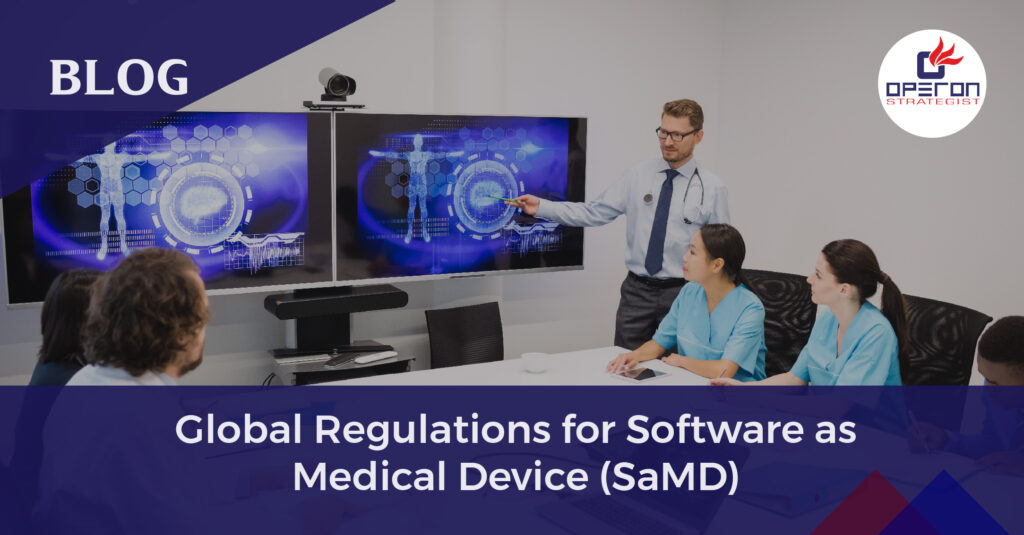Regulations For Software as Medical Device
In this digital era, the world is now building VR and AR software using AI and machine learning to keep up with the ever-changing world. Meanwhile, in recent times, we have started adapting Software-based medical devices that have no correlation to hardware devices.
Even if there is no direct relationship with hardware devices, many regulatory bodies still classify them as medical devices. In this blog, we will be going through all the important aspects of Software as a medical device (SaMD).
What is Software as a Medical Device (SaMD)?
The International Medical Device Regulators Forum (IMDRF), a non-profit organization of medical device regulators, describes Software as a Medical Device (SaMD) as the term “Software as a Medical Device” (SaMD) is defined as software intended to be used for one or more medical purposes that performs these purposes without being part of a hardware medical device.
But how will you know whether your product falls under the Software as a Medical Device (SaMD) or not? So, let’s understand exactly what software as a Medical Device (SaMD) is.
In the previous blog of Software as a Medical Device, We can see the key aspects and development process now let’s understand the regulations surrounding for this rapidly evolving field.
SaMD Regulations Around the Globe?
Regulations For Software as Medical Device
While there are many medical device markets around the world, the US and the EU are by far the largest, so let’s get a deep dive into this market.
The U.S. medical device market is anticipated to grow from $192.78 billion in 2022 to $291.04 billion by 2030. The FDA report says the United States imported more than $68 billion in medical equipment and exported about $59 billion in 2020.
Europe is the world’s second-largest market for medical devices. Revenue in the European Medical device market is expected to reach 136.30 billion dollars in 2023.
Let’s learn about some of the most important regulations in the US and Europe for Software as a Medical Device (SaMD).
All You Need to Know About USA Regulations for SaMD
Because the FDA recognizes that its existing medical device laws were largely created for traditional devices, it has issued particular guidance guidelines for software as a medical device (SaMD). The original premarket submission advice for SaMD was issued in 2005, but it is now deemed out of date. As a result, the FDA has written new guidance for 2021 to address the shifting SaMD scenario.
The difficulty arises because both the current and earlier recommendations define the documentation requirements for submitting SaMD based on its intended usage.
The current FDA guidance for software as a medical device (SaMD), issued in 2005, divides SaMD into three categories of concern depending on the possible severity of injury caused by device failure or design defects, as well as the level of danger to patients or operators.
- Minor
- Moderate
- Major
The guidance outlines specific documentation requirements based on the level of concern, which is distinct from the device’s risk class.
The three degrees of concern have been replaced by two levels of documentation: basic and enhanced, in new draught guidance that has yet to be finalized. This shift has caused some consternation among manufacturers. It is advised that you identify both the level of concern and the required documentation level (basic or enhanced) for your device until the draught advice is finalized.
All You Need to Know About EU Regulations for SaMD.
The European Union (EU) regulates software as a medical device (SaMD) in a manner comparable to that of the United States. SaMD, like traditional medical devices, is governed by the EU Medical Device Regulation (MDR) and the In Vitro Diagnostic Medical Device Regulation (IVDR). It is crucial to note, however, that the EU laws use the phrase “medical device software” (MDSW) rather than “software as a medical device.”
The European Commission (EC) has produced many advice documents pertinent to SaMD manufacturers’ regulatory compliance to assist them. These guidelines give extra clarification and directions for SaMD manufacturers operating in the EU.
All You Need to Know About CDSCO Regulations for SaMD.
In addition to the restrictions in the United States and Europe, understanding the regulatory landscape for Software as a Medical Device (SaMD) in India under the authority of the Central Drugs Standard Control Organization (CDSCO) is critical.
To assure the safety, efficacy, and quality of their goods, SaMD manufacturers in India must follow CDSCO requirements. Registration or licensing, adherence to quality management systems (QMS) standards such as ISO 13485, clinical evaluation studies, post-market surveillance, and adequate labelling and instructions for use are all examples of regulatory requirements.
Operon Strategist’s regulatory experience includes system implementation, training, licensing, regulatory approvals, certifications, and customized packages geared to the specific needs of our clients. Our global presence serves clients all around the world, ranging from small start-ups to well-known medical device makers.
Contact Operon Strategist for comprehensive regulatory compliance advice and ensure your SaMD fulfils all the rules and regulations.
- adminhttps://operonstrategist.com/author/admin-2/
- adminhttps://operonstrategist.com/author/admin-2/
- adminhttps://operonstrategist.com/author/admin-2/
- adminhttps://operonstrategist.com/author/admin-2/




